PEP英语全英教案模板
pep小学英语全册教案
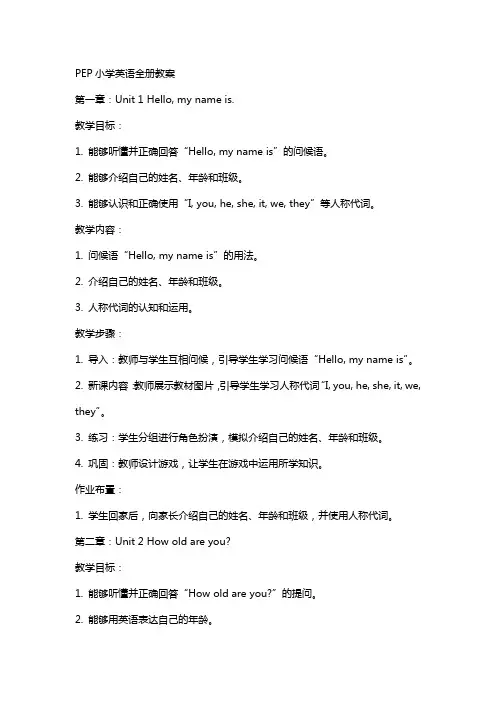
PEP小学英语全册教案第一章:Unit 1 Hello, my name is.教学目标:1. 能够听懂并正确回答“Hello, my name is”的问候语。
2. 能够介绍自己的姓名、年龄和班级。
3. 能够认识和正确使用“I, you, he, she, it, we, they”等人称代词。
教学内容:1. 问候语“Hello, my name is”的用法。
2. 介绍自己的姓名、年龄和班级。
3. 人称代词的认知和运用。
教学步骤:1. 导入:教师与学生互相问候,引导学生学习问候语“Hello, my name is”。
2. 新课内容:教师展示教材图片,引导学生学习人称代词“I, you, he, she, it, we, they”。
3. 练习:学生分组进行角色扮演,模拟介绍自己的姓名、年龄和班级。
4. 巩固:教师设计游戏,让学生在游戏中运用所学知识。
作业布置:1. 学生回家后,向家长介绍自己的姓名、年龄和班级,并使用人称代词。
第二章:Unit 2 How old are you?教学目标:1. 能够听懂并正确回答“How old are you?”的提问。
2. 能够用英语表达自己的年龄。
3. 能够认识和正确使用“I, you, he, she, it, we, they”等人称代词。
教学内容:1. 提问年龄的用法“How old are you?”。
2. 表达自己年龄的方式。
3. 人称代词的认知和运用。
教学步骤:1. 导入:教师与学生互相问候,引导学生学习问候语“How old are you?”。
2. 新课内容:教师展示教材图片,引导学生学习人称代词“I, you, he, she, it, we, they”。
3. 练习:学生分组进行角色扮演,模拟回答“How old are you?”的问题。
4. 巩固:教师设计游戏,让学生在游戏中运用所学知识。
作业布置:1. 学生回家后,向家长提问并回答“How old are you?”的问题。
2023最新-小学pep英语教案【优秀3篇】
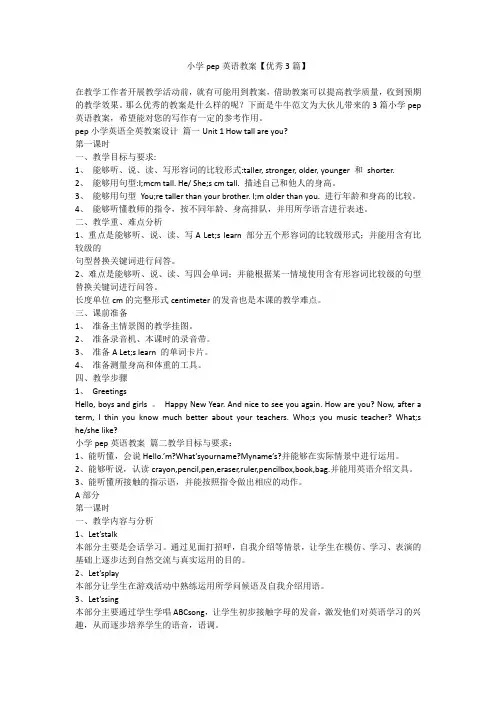
小学pep英语教案【优秀3篇】在教学工作者开展教学活动前,就有可能用到教案,借助教案可以提高教学质量,收到预期的教学效果。
那么优秀的教案是什么样的呢?下面是牛牛范文为大伙儿带来的3篇小学pep 英语教案,希望能对您的写作有一定的参考作用。
pep小学英语全英教案设计篇一Unit 1 How tall are you?第一课时一、教学目标与要求:1、能够听、说、读、写形容词的比较形式:taller, stronger, older, younger 和shorter.2、能够用句型:I;mcm tall. He/ She;s cm tall. 描述自己和他人的身高。
3、能够用句型You;re taller than your brother. I;m older than you. 进行年龄和身高的比较。
4、能够听懂教师的指令,按不同年龄、身高排队,并用所学语言进行表述。
二、教学重、难点分析1、重点是能够听、说、读、写A Let;s learn 部分五个形容词的比较级形式;并能用含有比较级的句型替换关键词进行问答。
2、难点是能够听、说、读、写四会单词;并能根据某一情境使用含有形容词比较级的句型替换关键词进行问答。
长度单位cm的完整形式centimeter的发音也是本课的教学难点。
三、课前准备1、准备主情景图的教学挂图。
2、准备录音机、本课时的录音带。
3、准备A Let;s learn 的单词卡片。
4、准备测量身高和体重的工具。
四、教学步骤1、GreetingsHello, boys and girls 。
Happy New Year. And nice to see you again. How are you? Now, after a term, I thin you know much better about your teachers. Who;s you music teacher? What;s he/she like?小学pep英语教案篇二教学目标与要求:1、能听懂,会说Hello.’m?What’syourname?Myname’s?并能够在实际情景中进行运用。
PEP小学英语教案全英文版
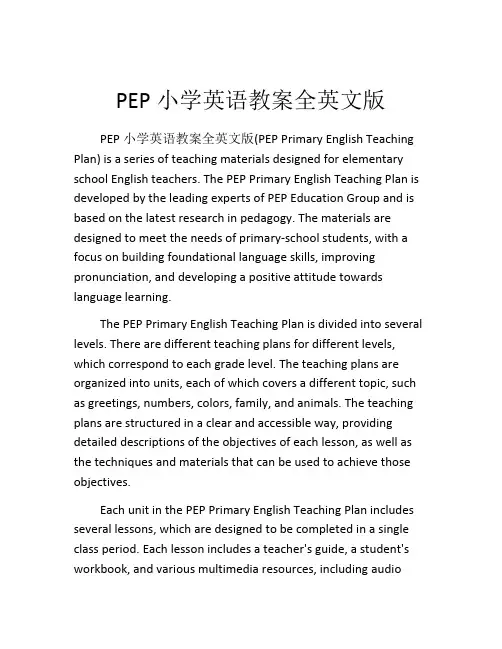
PEP小学英语教案全英文版PEP小学英语教案全英文版(PEP Primary English Teaching Plan) is a series of teaching materials designed for elementary school English teachers. The PEP Primary English Teaching Plan is developed by the leading experts of PEP Education Group and is based on the latest research in pedagogy. The materials are designed to meet the needs of primary-school students, with a focus on building foundational language skills, improving pronunciation, and developing a positive attitude towards language learning.The PEP Primary English Teaching Plan is divided into several levels. There are different teaching plans for different levels, which correspond to each grade level. The teaching plans are organized into units, each of which covers a different topic, such as greetings, numbers, colors, family, and animals. The teaching plans are structured in a clear and accessible way, providing detailed descriptions of the objectives of each lesson, as well as the techniques and materials that can be used to achieve those objectives.Each unit in the PEP Primary English Teaching Plan includes several lessons, which are designed to be completed in a single class period. Each lesson includes a teacher's guide, a student's workbook, and various multimedia resources, including audiorecordings, videos, and interactive games. The teacher's guide includes detailed explanations of each lesson's objectives, as well as step-by-step instructions for conducting activities and games that help reinforce those objectives. The student's workbook includes a variety of exercises and activities that can be used to reinforce the lesson's vocabulary and grammar points.One of the key features of the PEP Primary English Teaching Plan is its strong emphasis on interactive learning. The materials are designed to encourage students to participate actively in the learning process, rather than simply receiving information passively. The teaching plans include a variety of games, songs, and other activities that are designed to engage students and help them develop their language skills in a fun and enjoyable environment. In addition, the multimedia resources included with the teaching plans help to make the learning experience more dynamic and interesting.Another important feature of the PEP Primary English Teaching Plan is its focus on building a positive attitude towards language learning. The materials are designed to be engaging and stimulating, helping to create a sense of excitement and enthusiasm among students about learning English. The teaching plans also include materials that are specifically designed to help students overcome any obstacles or difficulties that they may encounter, such as pronunciation problems or difficulties with grammar or vocabulary.In conclusion, the PEP Primary English Teaching Plan is a comprehensive and effective teaching resource that is designed to help elementary school English teachers deliver high-quality language instruction. The materials are designed to meet the needs of primary-school students, with a focus on building foundational language skills, improving pronunciation, and developing a positive attitude towards language learning. With versatile teaching plans that use interactive learning methods, the PEP English plan can help children improve their English proficiency in a fun and inspiring way.。
pep四年级英语上册全英教案
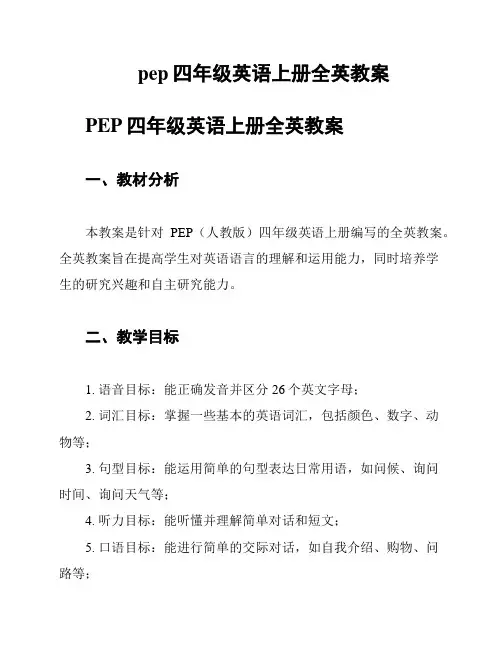
pep四年级英语上册全英教案PEP四年级英语上册全英教案一、教材分析本教案是针对PEP(人教版)四年级英语上册编写的全英教案。
全英教案旨在提高学生对英语语言的理解和运用能力,同时培养学生的研究兴趣和自主研究能力。
二、教学目标1. 语音目标:能正确发音并区分26个英文字母;2. 词汇目标:掌握一些基本的英语词汇,包括颜色、数字、动物等;3. 句型目标:能运用简单的句型表达日常用语,如问候、询问时间、询问天气等;4. 听力目标:能听懂并理解简单对话和短文;5. 口语目标:能进行简单的交际对话,如自我介绍、购物、问路等;6. 阅读目标:能阅读简单的英语短文,并提取关键信息;7. 写作目标:能书写简单的英文单词和句子。
三、教学内容1. Unit 1: Hello!- 研究问候语- 研究26个英文字母的名称和发音2. Unit 2: I'm Fine, Thank You.- 研究自我介绍语句- 研究数字1-10的表达方式3. Unit 3: What's Your Name?- 研究询问对方姓名- 研究询问和回答年龄4. Unit 4: How Are You?- 研究问候语表达方式- 研究回答问候的方式:I'm fine/good/not so good.5. Unit 5: Nice to Meet You.- 研究表达认识的方式- 研究简单的介绍他人6. Unit 6: My Family- 研究家庭成员的称呼- 研究家庭成员的简单介绍四、教学活动安排1. 听音乐活动:播放英语歌曲,帮助学生熟悉英文发音。
2. 观看视频活动:观看有趣的英语动画,帮助学生理解课文内容。
3. 绘画活动:让学生用颜色描述物品,锻炼英语表达能力。
4. 角色扮演活动:学生分组进行对话练,提高口语表达能力。
5. 外出实践活动:带学生到周边环境中,进行实地研究和口语练。
6. 课堂竞赛活动:布置英语小测验,激发学生研究的积极性。
全英教案模板(共9篇)
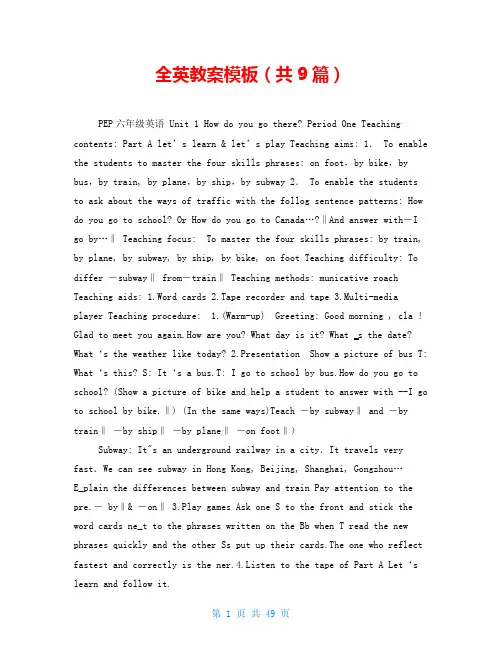
全英教案模板(共9篇)PEP六年级英语 Unit 1 How do you go there? Period One Teaching contents: Part A let’s learn & let’s play Teaching aims: 1. To enable the students to master the four skills phrases: on foot,by bike,by bus,by train, by plane,by ship,by subway 2. To enable the students to ask about the ways of traffic with the follog sentence patterns: How do you go to school? Or How do you go to Canada…?‖And answer with―I go by…‖ Teaching focus: To master the four skills phrases: by train, by plane, by subway, by ship, by bike, on foot Teaching difficulty: To differ ―subway‖ from―train‖ Teaching methods: municative roach Teaching aids: 1.Word cards 2.Tape recorder and tape 3.Multi-media player Teaching procedure: 1.(Warm-up) Greeting: Good morning , cla ! Glad to meet you again.How are you? What day is it? What ‗s the date? What‘s the weather like today? 2.Presentation Show a picture of bus T: What‘s this? S: It‘s a bus.T: I go to school by bus.How do you go to school? (Show a picture of bike and help a student to answer with --I go to school by bike.‖) (In the same ways)Teach ―by subway‖ and ―by train‖ ―by ship‖ ―by plane‖ ―on foot‖)Subway: It"s an underground railway in a city.It travels very fast.We can see subway in Hong Kong, Beijing, Shanghai, Gongzhou…E_plain the differences between subway and train Pay attention to the pre.― by‖& ―on‖ 3.Play games Ask one S to the front and stick the word cards ne_t to the phrases written on the Bb when T read the new phrases quickly and the other Ss put up their cards.The one who reflect fastest and correctly is the ner.4.Listen to the tape of Part A Let‘s learn and follow it.Pay attention to the tone and pronunciation 5.Practice: Let‘s playT Offer many places (the USA.England Australia Hong Kong Shanghai Guangzhou the moon…) and traffic ways (by car/ ta_i/ bus… on foot) Ss practice with above places and ways in pairs: A: How do you go to school? B: I go to school on foot .Encourage the Ss to make up as many sentences as they can.6.Spelling petition Divide the cla into tow groups.Show the pictures of traffic tools and ask Ss to spell the phrases.The first one who puts up hand gets the chance to spell.The group spell out more phrases are the ners.Homework Copy the new words and phrases FinishPage1 of the AB Bb design: Unit One How do you go there? How do you goto school/ Canada? I go to school on foot/ by subway/ bus/ train/ ta_i…Teaching Plan for Unit 5 JEFC Book1What Would You Like? Aims a) Say the names of food in English.b) Write down the names.c) Master these sente nces: I’m hungry.What would you like? I’dlike some……d) Use these words (food’s names) correctly.Importance and Difficulties a) New words: hamburger, vegetable, hot dog…… b) Spelling and pronunciation of some words.C) Grammar and Structure: can I have some rice, please? Sure.Here you are.What wouldyou like for dinner? I’d like some ……Teaching method: “Task-based “Teaching, “Activity-based” Teaching,“municative-based” Teaching.Teaching aids: puter, medium, chalk, cards.Teaching ProceduresStep1: Review (10mins) a) Warming up: a song: (with medium)b) Let students imagine what kinds of food do they like and then draw something on the paper.c) Call students to show their ideas (like:oh, I like hamburger……) and present pictures.d) Teacher summarize (you are all good students full of imagination and all did a good job ……) then write the words (hamburger, vegetable, hot dog……) on theboard.Step2, Learn the new words and structures (15mins) a) Show the cards to introduce the new words.b) Students reading the new words follow me, and each word twice, then they read them loudly by themselves.C) Learn and analysis the sentence structures: can I have some rice, please? Sure.Here youare.What would you like for dinner? I’d like some ……Step3: more practice (10mins) a) Reading.Teacher show the cards and then all the students read it loudly.(What would you like? What is this?)b) Do a word game.Teacher show the pictures and then some volunteer read it as soon as poible.(the ner will get the prize) c) Use to show some pictures about food’s names to make students enjoy in it.d) Make a role play.Make a dialogue.Let 3 Ss take part in it (waiter C, dad B and daughter A ).It is in the restaurant.A: Dad, I’m hungry.What for dinner? B: Oh, baby, what would you like? A: I’d like hamburger, rice, fish, vegetables, please.B: Waiter! Waiter! C: What can I do for you, sir? A: We’d like some hamburger, rice, fish, vegetables, please.C: Ok.A: Thank you, Dad.e) Make sure students pronounce the words and use the sentences correctly.Homework: Pronounce and spell these words correctly.Write apaage about “what would you like?” I will check it ne_t cla.ments: Filled in as soon as poible after the leon.Module1 The Great Wall1、Teaching preparing:Students book:Module1Unit 1Activity1, 2, 32、Teaching task: A.basic object:Key words:thousand postcard more kilometerKey sentences: “These postcards are great!” “It‟s a picture of the Great Wall.” “Tell me more about the Great Wall.” “How long is it?B .To learn “thousandkilometermillion ” C.Review: The using way of the verb …be‟ 2.Talking about some famous places.3、Teaching point: words:thousandkilometermillion postcardmore4、Teaching difficulty:kilometerthousandmillion“Tell me more about the Great Wall.“It‟s a picture of the Great Wall.”5、Task design: words:postcardmorethousandkilometermillionSentences: “These postcards are great!” “It‟s a picture of the Great Wall.” “Tell me more about the Great Wall.” “How long is it?”“It‟s about si_ thousand seven h undred kilometers.”的句型。
小学pep英语教案5篇
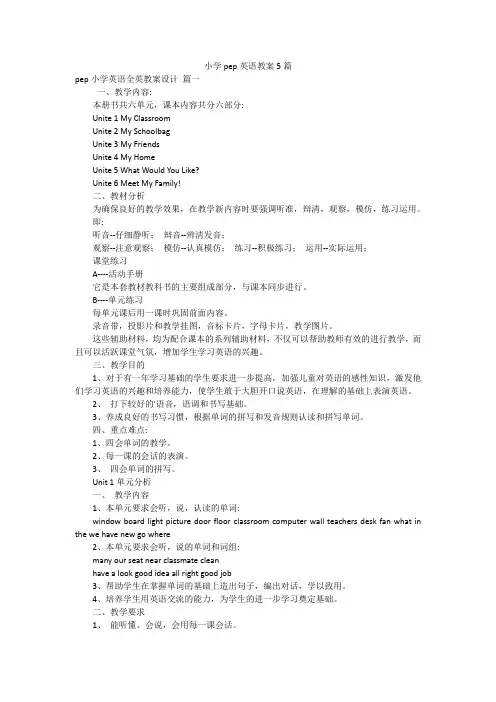
小学pep英语教案5篇pep小学英语全英教案设计篇一一、教学内容:本册书共六单元,课本内容共分六部分:Unite 1 My ClassroomUnite 2 My SchoolbagUnite 3 My FriendsUnite 4 My HomeUnite 5 What Would You Like?Unite 6 Meet My Family!二、教材分析为确保良好的教学效果,在教学新内容时要强调听准,辩清,观察,模仿,练习运用。
即:听音--仔细静听;辩音--辨清发音;观察--注意观察;模仿--认真模仿;练习--积极练习;运用--实际运用;课堂练习A----活动手册它是本套教材教科书的主要组成部分,与课本同步进行。
B----单元练习每单元课后用一课时巩固前面内容。
录音带,投影片和教学挂图,音标卡片,字母卡片,教学图片。
这些辅助材料,均为配合课本的系列辅助材料,不仅可以帮助教师有效的进行教学,而且可以活跃课堂气氛,增加学生学习英语的兴趣。
三、教学目的1、对于有一年学习基础的学生要求进一步提高,加强儿童对英语的感性知识,激发他们学习英语的兴趣和培养能力,使学生敢于大胆开口说英语,在理解的基础上表演英语。
2、打下较好的'语音,语调和书写基础。
3、养成良好的书写习惯,根据单词的拼写和发音规则认读和拼写单词。
四、重点难点:1、四会单词的教学。
2、每一课的会话的表演。
3、四会单词的拼写。
Unit 1单元分析一、教学内容1、本单元要求会听,说,认读的单词:window board light picture door floor classroom computer wall teachers desk fan what in the we have new go where2、本单元要求会听,说的单词和词组:many our seat near classmate cleanhave a look good idea all right good job3、帮助学生在掌握单词的基础上造出句子,编出对话,学以致用。
最新完整版小学英语全英语教案全人教版pep
最新完整版全英语教案…小学英语教案Teaching Content句型:This is……Eg. -Good morning! This is Lucy.-Good morning![Teaching aims]Language aims:1.Ss can read the dialogue fluently and imitate the dialogue.2.Ss can perform the dialogue.3.Ss can introduce their friends to others with the target language “This4.Ss can understand the usage of “This is.・Ability aims:1.Ss can master the target language pattern “This is.・and use it incorrect way.Emotional aims:2.Ss can improve their ability of imitating pronunciation and intonationnaturally and correctly.3.Stimulate students1interest in learning English and arouse theirenthusiasm for learning.(Learning important points]1.Ss can introduce the ir friends to others with the language pattern “Thisis...”.2.Practice the usage of" This is.・[Learning difficult points]1.The pronunciation of 4T,and " th” is quite difficult fbr Ss.2.Ss can understand the target sentence “This is...” and use it correctly. [Teaching aids] blackboard, multi-media, PPT, masks[Teaching Procedures]Stepl Warm-up & lead-in1.Teacher play the song “Good morning'' and Ss tiy to sing along. Make Ssfocus on the class and arouse their interest in learning.2.The teacher used masks to introduce the characters. For example, teacherputs on the mask of Miss White, and say " Good moming boys and girls, Tm Miss White.”3.Invite three Ss to act as Miss White, Mr. Jones and Miss Green. Ss greetwith each other in English.Step 2 Presentation1.Teachers and students watch teaching courseware. The courseware contentis " Let's Talk”. The teacher use the same teaching courseware as the teaching material, so that the students can see clearly and understand the meaning of the sentence pattern and the use of sentence pattern.2.Watch the courseware again, then ask Ss: " Wliat are they doing?”3.The teacher perfbnn "Let's talk” to enable students to understand thedialogue further.Performance: The teacher put on Miss White's headdress, held up Mr.Jones1 mask with his left hand, and raised the mask of Miss Green with his right hand, perform the dialogue in different tones. In this performance, the teacher emphasized the sentence pattern “This is...”.4.Show Ss the key sentence pattern “This is..on PPTStep3 Practice1.Listen to the dialogue in "Let's talk” , students follow and imitatethe pronunciation. Pay attention to the difficult pronunciation of ‘T' and “th”. Conect students1 inconect pronunciation2.group work3.Ask three Ss as a group, and practice the dialogue---Good moniing! This is...——Good morning!Step3 ConsolidationDraw and say1.Let the students draw a headdress of a familiar person on the paper.2.Ask Ss to introduce the person they drawn to their desk mates using thesentence “ Good moniing! Tliis is3.Invite two or three groups to show their performance.Step4 Production1.Ask Ss to paint your favorite person or cartoons on paper, using “ Goodmorning! Tliis is .・・・'' to introduce to the whole class.2.Write down this sentence patternStep 5 Summary and Homework1.Ss read the dialogue in "Let's talk^ together.2.Teacher give a summary.Homework1.Recite the dialogue.Step 6 Blackboard DesignUnit 2-Good morning! This is...-Good morning!Step7 Self-reflection。
小学英语教学目标全英教案模板(共3篇)
小学英语教学目标全英教案模板(共3篇)第1篇:小学英语全英教案小学英语全英教案范文【篇1:全英文英语教案模板】leon plannsefc module2 unit reading in teacher: period:period1 type:reading duration: 45minutes teaching ideologythe current theory view reading as a interactive proce which involves not only the printed page but also the reader’s old knowledge of the language in general, the world and the text types.in the reading proce, these factors interact with each other and compensate for each other.based on the understanding of reading as an interactive proce, teaching reading in the claroom is divided into three stages in which the top-down and bottom-up techniques integrated to develop the students language efficiency in general and reading strategies.the three stages are pre-reading, while-reading and post-reading.teaching material and learning condition the analysis of teaching material the teaching material is the reading part from nsefc module2 unit.the topic of this unit is.this paage mainly introduces the paage consists of paragraphs.the first paragraph is a general introduction of the.para.2 to para.4 introduces.the last paragraph tells about.the topic is not new to the.but there is some new words and phases in the paage.the analysis of learning condition the students are from grade1 in senior high school.as high school students, they have achieved certain english level and they have the ability to get the basic idea of the reading.since they are in grade1, they are easily activated and want to air their own opinions on the topic.they are familiar with the topic of andknow some.but they may not know before.moreover, their vocabulary is limited so they may have difficulties in understanding some sentences.learning objectives nguage skills ? at the beginning of the cla, can predict the content of the paage based on the title.? can scan the paage and find out the specific information such as the person related withcan summarize the paage with the help of the clues of the nguage knowledgecan master the key words and phrases of the paage as follows,.? can learn , especially 3.affectswill realize that and they will concern themselves with the iue of4.cultural awarenewill broaden their minds by knowing something about 5.learning strategieswill cultivate their ability individual learning and cooperative learning by doing someactivities independently and some in groups.? will communicate with each other in english while doing the group nguage difficultiesfocuses and anticipated language focusesthis is a reading period so the focus is to cultivate the students’ reading skills.the many activities are designed to help to train their reading skills, such as predicting, skimming, scanning and summarizing.it is also important for the to master the new words and phrases.anticipated difficultiesas the have a limited vocabulary, so they may have some difficulties in understanding the paage.so the teacher will help them learn the new words and phrases.may did not heard before, so the teacher will tell them some background knowledge aboutit.teaching methodthree-stage model: based on the understanding of reading as an interactive proce, teaching reading in the claroom is divided into three stages in which the top-down and bottom-up techniques integrated to develop the students language efficiency in general and reading strategies.the three stages are pre-reading, while-reading and post-reading.teaching aids multimedia devices and ppt documents: in order to help to fully understand the whole paage, i adopt multimedia devices and ppt documents to bring the real-life situation into the claroom.teaching procedures step1.lead-in(6min)activity1.greetings and free-talking(2min)t leads into the topic by asking some they know.tell the name of the they know freely.t: hello boys and girls.(say hello to the teacher.)t: when we say , what appears in your minds?(tell the things appear in their minds freely.)t: what are the ?(tell some names of.) activity2.picture-talking(4min)t shows some pictures about the in china and abroad.after seeing the pictures, are expected to tell the similarities of them.t: just now, you talk about some in china.now, let’s see some pictures of some.(t shows the pictures and see them carefully.) t: what do the have in common?for example, they are very precious.what are your opinions?(t gives them some hints and tell the characteristics of)[aims] in this step, t first leads in the topic by talking with the freely about the whichis familiar to them and then see some pictures and tell the characteristics.these two activities aim to arouse the ’ interests in the topic and activate their old knowledge of.then will bementally prepared for the reading comprehension.what’s more,when they are talking about the charateristics of, they will realize that theare rare and precious and they will concern themselves with the iue of.step2.pre-reading(3min)activity1.knowing something about(1min)t gives a brief introduction of the.will know the t: today, we are going to learn.it is.do you know what is?(t shows some pictures ofand get to know the.)activity2.predicting(2min)t asks to read the title of the paage and then ask them some questions.will predict the content of the paage with the help of the title.t: please look at the ti tle “”, what does “” mean?(if the can not give the answer, then t explain it.)t: in search means that people are looking for it.why are people looking for it? can you gue? what will the paage talk about?(predict the content, but t will not give the answer here.)[aims] in this step, the first know some information of the;the background information will make it easier for the to understand the paage.then t asks to make predictions about the paage.it aims to help develop the reading skills of predicting.step3.while-reading(22min)activity1.skimming(4min)skim the whole paage and find out and check their predictions.t: why are people still ? here is a multiple choice for you.activity2.scanning(3min)t presents several true or false statements and asks the to scan the paage and judge the right from the wrong.(keys: F,F,T,T,F)activity3 close-reading(15min)t designs various kinds of activities and do the activities to fully understand the paage.para.1t: please read para.1 carefully and then take some note aboutthe.para.2-4please read para.2-4 carefully and then find out the removal of the room.please read para.2-4 carefully and then find out the person related with the amber room and the things them down with it.para.5 please read para.5 carefully and then find out the the rebuilding of the amber room.【篇2:pep小学英语全英教案模板】the english teaching plan of pep book 4enhe primary school teacher:___________ the curriculum schedule cla:____________ cla:____________ the teaching schedule the students’ result tablethe english curriculum standard英语课程标准一级目标总体目标:对英语有好奇心,喜欢听他人说英语;能根据教师的简单指令做游戏、做动作、做事情(如涂颜色、连线);能做简单的角色扮演;能唱简单的英文歌曲,说简单的英语歌谣;能在图片的帮助下听懂和读懂简单的小故事;能交流简单的个人信息,表达简单的情感和感觉;能书写字母和单词;对英语学习中接触的外国文化习俗感兴趣。
pep三年级上册全英教案
pep三年级上册全英教案【篇一:pep小学英语三年级上册教学设计全册】unit 1hello第一课时教学目标1 听懂会说 hello! hi! goodbye/ bye-bye.2 了解学习英语的重要性。
3 掌握 im句型.教材分析本节课是本学期开学的第一课,也是学生接触英语的第一课,本节课是本单元的基础,重点是让学生听懂会说一些简单的问候语,并能介绍自己。
这也是本节课的难点。
主要采取师生、生生互相合作,学生在愉快的学习氛围中习得和学得。
学生分析学生第一次接触英语课,都很感兴趣、积极,学习热情也比较高,可通过学生的兴趣与积极性,培养学生的语感。
【教学准备】教师:录音机、磁带、人物头饰。
学生:课本、活动手册。
【板书设计】unit 1 ahello!tv vcddvdim sarah.im miss zhang.goodbye!【教学过程】一、warm-up看开头的welcome to english. 彩图让学生学会说词汇tv,cd, vcd, dvd, ok! h! yeah! bye, cool! wow! e-mail, cartoon. 来激发学生兴趣。
学生学习这些单词有部分学生在日常生活中已经学会。
【设计意图】:通过简单的词汇,激发学生兴趣。
使学生有一个好的开头。
二、presenation1. 播放hello录音教师与学生打招呼:hello, boys and girls.ss: hello, miss huang.2. 教师扮演 sarah, 与学生打招呼。
【设计意图】:达到师生互动教学。
3. 学生one by one练习【设计意图】:达到生生互动教学。
三、practice1. play a game 猜一猜 who is he/she?学生说hello,让另一学生猜他是谁,学生参与活动。
2. 击鼓传话,传到谁谁就来做自我介绍。
【设计意图】:通过游戏,即激发了学生兴趣,又使学生在宽松的情景下巩固复习了所学知识。
小学pep英语教案优秀 (通用3篇)
小学pep英语教案优秀(通用3篇)小学pep英语教案篇一She learnt English.教学目标1.学会词汇learnt these dancer2.能听懂会说Unit 1这篇对话。
3.学习目标语句:Did your grandma learn English? Yes, she did. /No, she didn’t.4.能口头运用Did your grandma learn English?这类语句询问过去的行为,并能口头运用Yes, she did./No,she didn’t.回答。
教学重点:学会词汇learnt these dancer教学难点:运用目标语句She danced in lots of Chinese cities .Did she learn any foreignlanguages? Yes, she did. /No, she didn’t. He was a dancer .谈论过去。
教学过程:Step1.预习检测根据所给单词,补全句子。
1. Sam he isXXXXX.(short tall)2. My motherXXX sheXXX XXX.(old young)Step2.合作探究,学习课文。
1. 听课文录音,理解课文大意。
2. 小组内学习课文。
3. 师解决疑惑。
4. 学生自己读课文,找出下面问题的答案。
Who are they ?Why is she wearing these clothes?Did she learn English?Step3.巩固练习小学pep英语教案篇二一、教学内容本节课的设计是针对《义务教育课程规范实验教科书英语PEP》四年级上册Unit 2 My schoolbag Part A Let’s learn Let’s do部分。
通过本节课的学习,同学能够掌握对话A和English book, maths book, Chinese book, story-book,notebook,schoolbag这几个单词。
- 1、下载文档前请自行甄别文档内容的完整性,平台不提供额外的编辑、内容补充、找答案等附加服务。
- 2、"仅部分预览"的文档,不可在线预览部分如存在完整性等问题,可反馈申请退款(可完整预览的文档不适用该条件!)。
- 3、如文档侵犯您的权益,请联系客服反馈,我们会尽快为您处理(人工客服工作时间:9:00-18:30)。
(此文档为word格式,下载后您可任意编辑修改!) The English Teaching Plan
of PEP Book 4
Enhe Primary School
Teacher:___________
The Curriculum Schedule
Class:____________
Class:____________
The Teaching Schedule
The Students’ Result Table
写字母和单词;对英语学习中接触的外国文化习俗感兴趣。
听做:
1.能根据听到的词语识别或指认图片或实物;
2.能听懂课堂简短的指令并做出相应的反应;
3.能根据指令做事情,如:指图片、涂颜色、画图、做动作、做手工等;
4.能在图片和动作的提示下听懂简单的小故事并做出反应。
说唱:
1.能根据录音模仿说英语;
2.能相互致以简单的问候;
3.能相互交流简单的个人信息,如:姓名、年龄等;
4.能表达简单的情感和感觉,如:喜欢和不喜欢;
5.能根据表演猜测意思、说词语;
6.能说唱英语儿童歌曲15-20首,说歌谣15-20首;
7.能根据图、文说出单词或短句。
玩演:
1.能用英语做游戏,并在游戏中用英语进行简单的交际;
2.能做简单的角色表演;
3.能表演英文歌曲及简单的童话剧,如《小红帽》等。
读写:
1.能看图识字;
2.能在指认物体的前提下认读所学词语;
3.能在图片的帮助下读懂简单的小故事;
4.能正确书写字母和单词。
视听:
1.能看懂语言简单的英语动画片或程度相当的教学节目;
Analysis of the textbook:。
